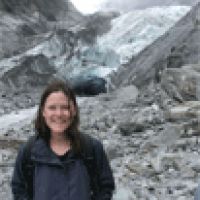Summer REUs use seismic techniques to gather data on subsurface structure
To improve understanding of the shallow critical zone structure at Shale Hills, two REU students along with CZO post-doc scholar Nicole West and Professor of Geosciences Andrew Nyblade set up field experiments in the open soil pits on both the northern and southern slopes. To perform the near surface refraction survey, geophones are placed in the soil pit walls, to a depth of 1 meter below the ground surface. Vibrations are created by sledge hammers and strike plates and the ensuing seismic waves are recorded by the geophones. Timing and intensity of the waves may be used to calculate material velocities, which will further knowledge of the subsurface structure.
Professor Andy Nyblade recommends shot techniques to Reese Davis and Austin White-Gaynor (Department of Geosciences graduate student) for a cross-pit seismic survey. Photo by Nicole West.
Professor Andy Nyblade recommends shot techniques to Reese Davis and Austin White-Gaynor (Department of Geosciences graduate student) for a cross-pit seismic survey. Photo by Nicole West.
Recent Department of Geosciences graduate, Reese Davis (Class of 2014), installing horizontal geophones into a bench cut along the soil-colluvium interface for an in situ siesmic survey of the southern hillslope at the Shale Hills Critical Zone Observatory. Photo by Nicole West.
News Category:
RESEARCH |
EDUCATION/OUTREACH
Explore Further




